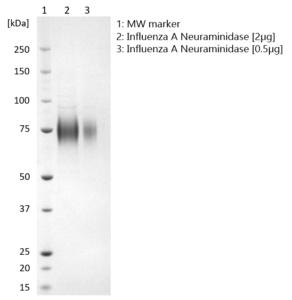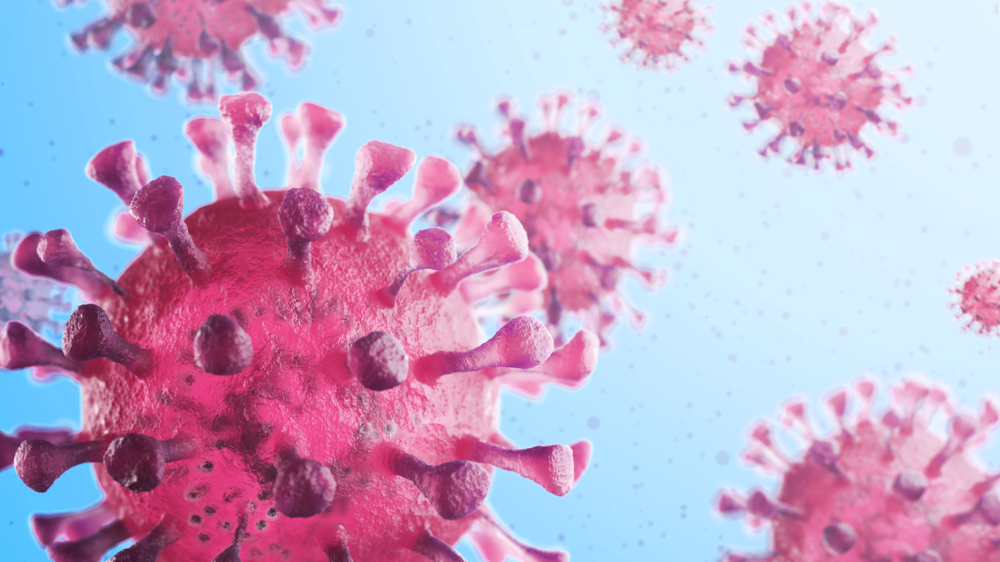
SDS-PAGE: Coomassie-stained reducing SDS-PAGE showing purified Influenza A [A/Hong Kong/45/2019 (H3N2)] Neuraminidase (NA) protein.
Influenza A [A/Hong Kong/45/2019 (H3N2)] Neuraminidase (NA), His-Tag
Price range: $586.49 through $2,055.80 excl. VAT
A recombinant influenza virus neuraminidase protein derived from the NA sequence of A/Hong Kong/45/2019 (H3N2), expressed and purified from HEK293 cells as aa 31-468, and fused with a polyhistidine tag at the C-terminus. This virus is recommended by WHO for inclusion in the quadrivalent and trivalent vaccines for use in the 2020 – 2021 northern hemisphere influenza season.
INFLUENZA A [A/Hong Kong/45/2019 (H3N2)] NEURAMINIDASE (NA), HIS-TAG
This Influenza virus neuraminidase protein is derived from the NA sequence of the A/Hong Kong/45/2019 (H3N2), expressing aa 31-468, and fused with a polyhistidine tag at the C-terminus. The influenza virus neuraminidase protein is expressed in HEK293 cells. This virus is recommended by WHO for inclusion in the quadrivalent and trivalent vaccines for use in the 2020 – 2021 northern hemisphere influenza season.
PRODUCT DETAILS – INFLUENZA A [A/Hong Kong/45/2019 (H3N2)] NEURAMINIDASE (NA), HIS-TAG
- Recombinant Influenza A neuraminidase of the A/Hong Kong/45/2019 (H3N2) strain (NCBI Accession Number: EPI1588463 (GISAID)), amino acids 31-468 and a C-terminal His-tag.
- Expressed in HEK293 cells, and purified from culture supernatant by immobilised metal affinity chromatography and buffer exchange.
- Presented as liquid in DPBS and greater than >95% purity by SDS-PAGE.
BACKGROUND
The influenza A viruses are negative-sense, single-stranded, segmented RNA viruses of the genus Alphainfluenzavirus, family Orthomyxoviridae. There are several subtypes, named according to the type of Haemagglutinin (H1-18) and Neuraminidase (N1-11) (CDC, 2017). Humans are generally infected by influenza viruses of the subtypes H1, H2 or H3, and N1 or N2. Influenza A virus subtype H3N2 (A/H3N2) is a subtype of viruses that causes influenza (flu) and can infect birds and mammals. In birds, humans, and pigs, the virus has mutated into many strains and in years in which it is the predominant strain, there are usually more hospitalizations. The Hong Kong flu was the first known outbreak of the H3N2 strain, and the 1968- 1969 pandemic killed an estimated one million people worldwide (CDC, 2019). WHO convenes technical consultations in February and September each year to recommend viruses for inclusion in influenza vaccines for the northern and southern hemisphere influenza seasons, respectively. Flu vaccines are based on predicting which mutants of H1N1, H3N2, H1N2, and influenza B will proliferate in the next season. Separate vaccines are developed for the Northern and Southern Hemispheres in preparation for their annual epidemics. Over the last decade, H3N2 has tended to dominate in prevalence over H1N1, H1N2, and influenza B. WHO has identified four strains as the most likely to circulate in the 2020-2021 influenza season, including Influenza A/Hong Kong/45/2019 (H3N2)-like virus.
REFERENCES
-
- Centers for Disease Control and Prevention (CDC). (2017). Influenza Type A Viruses.
- Centers for Disease Control and Prevention (CDC). (2019). 1968 Pandemic (H3N2 virus).
- World Health organisation (WHO). Influenza. Recommended composition of influenza virus vaccines for use in the 2020 – 2021 northern hemisphere influenza season (2020).

